Dragon 1/32 P-51D-5 Mustang
|
KIT #: |
3205 |
|
PRICE: |
$45.00 (approx-look for bargains)16.98
|
|
DECALS: |
Three options |
|
REVIEWER: |
Tom Cleaver |
|
NOTES: |
Kits World Decals
KW132001 “Passion Wagon” used.
Rutman Productions propeller blades used.
Greymatter Figures resin cockpit used. |
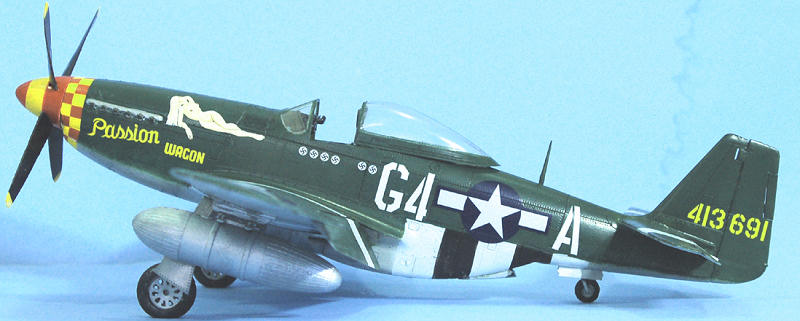
The 357th Fighter
Group:
The 357th Fighter Group was the first unit originally equipped with the
P‑51 Mustang to serve in the Eighth Air Force.
Following the decision to assign the 9th Air Force's 354th Fighter Group
to operational control of the Eighth as a long‑range escort group, Eighth Air
Force command moved heaven and earth to get the nest P‑51 units destined for the
Ninth reassigned to the Eighth.
They swapped the new P‑47‑equipped 358th Fighter Group for the P‑51‑equipped
357th after convincing the Ninth that P‑47s were better suited for the ground
attack role that air force would be assigned to for the invasion ‑ a fact fully
demonstrated by history.
The 357th was formed on December 16, 1942 at Hamilton Field, north of San
Francisco, and had spent some eight months training its newly‑minted pilots with
the P‑39, first at Hamilton and later at Tonopah, Utah, where flight
restrictions were fewer since there were less people to possibl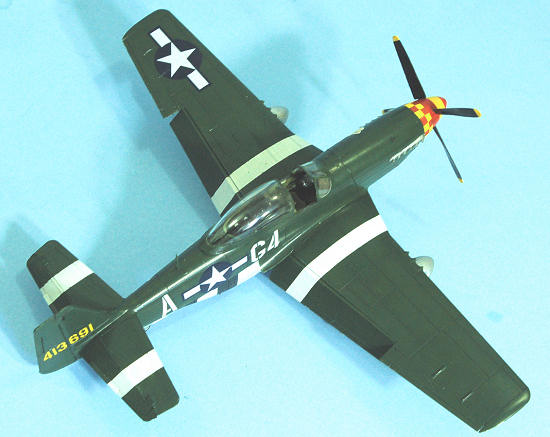 y
complain about any “flat‑hatting,” though 14 pilots were killed in accidents
during this time. The unit was ready for transfer to
England
in October 1943, at which time they learned they would be the second fighter
group to be equipped with the P-51B.
y
complain about any “flat‑hatting,” though 14 pilots were killed in accidents
during this time. The unit was ready for transfer to
England
in October 1943, at which time they learned they would be the second fighter
group to be equipped with the P-51B.
The 357th entered combat on
February 11, 1944,
at the opening of what was known as “Big Week,” an offensive directed against
the Luftwaffe and the factories supporting it, which actually lasted throughout
February with missions being flown every day the weather allowed.
It was the “opening bell” of The
Battle
of
Germany,
the effort to defeat the Luftwaffe and gain air superiority over
Western Europe
by the summer, when the invasion was set.
The P‑51Bs
of the 357th were the first allied fighters over
Berlin
on
March 4, 1944
, along with the 336th Squadron of the 4th Fighter Group. Flying Mustangs
insured the unit would be assigned the hottest part of the missions ‑ target
escort ‑ where they were almost certain to always meet the Luftwaffe.
Throughout March and April the battle raged, with the Luftwaffe finally
unable to meet a major attack in mid‑April.
During the Spring of 1944, the Luftwaffe lost 70 percent of their
squadron and flight leaders, as well as several of their group and wing
commanders, in addition to other veteran pilots.
It was a loss the Luftwaffe could ill afford and would never be able to
replace.
By late April, American fighters were strafing German airdromes on the
way back from their escort missions, due to the fact the Luftwaffe wasn't coming
up to fight. By May, the Luftwaffe
had been effectively beaten. That
air superiority had been achieved was demonstrated by the fact that only two
Luftwaffe fighters showed up over the invasion beaches on June 6.
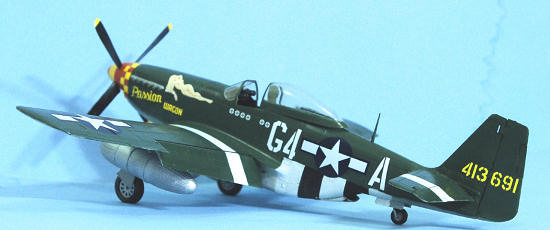 Throughout
the summer of 1944, the fighters of the Eighth, along with those of the Ninth
that were more and more based in
France,
took on the Luftwaffe over the battlefield of northwestern
France.
By the end of August, with
Paris
liberated, the Luftwaffe was a shadow of its former self and could never mount
more than token resistance throughout the rest of the war. The untested kids of
units like the 357th had smashed what had been considered the world's leading
air force.
Throughout
the summer of 1944, the fighters of the Eighth, along with those of the Ninth
that were more and more based in
France,
took on the Luftwaffe over the battlefield of northwestern
France.
By the end of August, with
Paris
liberated, the Luftwaffe was a shadow of its former self and could never mount
more than token resistance throughout the rest of the war. The untested kids of
units like the 357th had smashed what had been considered the world's leading
air force.
In August, the 357th escorted B‑17s to
Russia,
Italy
and back home on one of the shuttle missions. During Operation Market Garden ‑
the airborne landing in northern
Holland
in September ‑ the 357th destroyed 50 enemy aircraft in two days. On
January 14, 1945,
the group fought its biggest battle and experienced its greatest success when
the three squadrons shot down 55.5 German fighters over
Berlin,
in what would be the last major combat of that size of the war.
By V‑E Day, the 357th Fighter Group had produced the highest number of
aces in the Eighth Air Force ‑ (43), five of whom scored more than 15 victories
and four of whom scored more than 10.
This widespread “acedom” was a credit to leadership throughout the group.
The 357th scored 695 air victories, making them second in aerial combat
to the 56th Fighter Group, which was in combat a year longer.
I am certain that my “review” of the initial release of Dragon's P-51D
kit is burned into the frontal lobes of readers.
To say it caused a “sensation” is an understatement.
I could have wallpapered my house by printing out the e-mails bemoaning
my act of lese majesty, which was sure to result in model companies
refusing to release any more models since people like me were “wrecking the
hobby” with our attacks on the poor model companies.
Dragon itself launched a campaign against me on their website, which can
probably be listed as one of the more ignorant corporate decisions made, since
my in-box was bulging with queries from readers about the kit, and general
laughter at Dragon for so stupid as to do such a thing.
As almost all the many
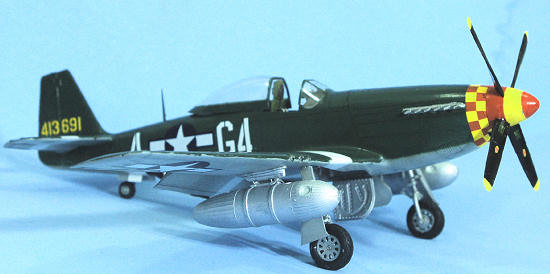 reviews of
the kit that sprouted on the internet in the months following revealed, a lot of
modelers wanted to prove me wrong, though their results were unconvincing on
that point, as was also pointed out by readers.
reviews of
the kit that sprouted on the internet in the months following revealed, a lot of
modelers wanted to prove me wrong, though their results were unconvincing on
that point, as was also pointed out by readers.
So I am sure it is surprising to see this model reviewed here today.
However, this P-51D-5 is not quite the pig that the original release was,
though it is still “unbuildable” (if by that term you mean the final result out
of the box is an accurate model) without a lot of aftermarket items, all of
which I used here. However, there
is one important difference in this kit: the “moonscape” surface detail of the
original release has been toned down (it may also be that I have been
desensitized to overdone surface detail, now that so many kits have been
released that way). This is a common trick of Dragon with their armor kits, to
respond to criticism by correcting things while admitting nothing in public.
Unfortunately, the serious problems remain.
Additionally, this is the only kit of the early P-51D that has been
produced by any company. While I
wish they had also modified the elevators to create fabric-covered items, the
fact that most early Mustangs were re-equipped with metal elevators as soon as
they became available covers the problem.
However, even with the less-offensive surface detail and the provision of
a sub-type not previously available in any scale, the basic problems of the kit
remain. One definitely must get
aftermarket prop blades; I was lucky to obtain a set from Jerry
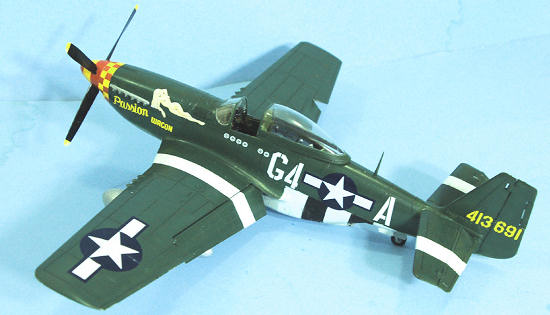 Rutman
before he closed up shop, but I do not know any other replacements, so a modeler
is on their own at that point. I
was also fortunate to receive a resin cockpit from Greymatter Figures; this
cockpit was originally created for the 1/32 Hasegawa kit and they were
interested to find out if it could work with the Dragon kit, which it can with
some modifications. I wish I had
been able to use the Scale Aircraft Conversions white metal landing gear and
True Details resin main gear, because the parts provided in the kit are
deficient.
Rutman
before he closed up shop, but I do not know any other replacements, so a modeler
is on their own at that point. I
was also fortunate to receive a resin cockpit from Greymatter Figures; this
cockpit was originally created for the 1/32 Hasegawa kit and they were
interested to find out if it could work with the Dragon kit, which it can with
some modifications. I wish I had
been able to use the Scale Aircraft Conversions white metal landing gear and
True Details resin main gear, because the parts provided in the kit are
deficient.
What tipped things in favor of proceeding with the project was getting
the Kits World Decals that provide markings for the well-known “Passion Wagon”
of the 357th Fighter Group. I wasn't ready to try doing this kit with
a natural metal finish that would expose all that surface detail, but a nice
dark overall camouflage scheme could change things.
For modelers who have this kit in their stash and my be convinced by this
review to build it, Eagle Editions has also released three sheets of 1/32 decals
for 357th FG Mustangs in overall camouflage, which I would recommend.
I started by working on corrections to the kit parts.
I had no intention of using the engine and mount provided in the kit, so
I glued the clear cowling parts in position and strengthened the joints by
reinforcing them with Evergreen strip on the inside.
I wanted to drop the flaps, which involved dremeling out the area under
the wing fairing on the fuselage as well as adding some Evergreen sheet to the
separate flaps; after I puttied that area and cleaned it up, I also used my
pounce wheel to replace
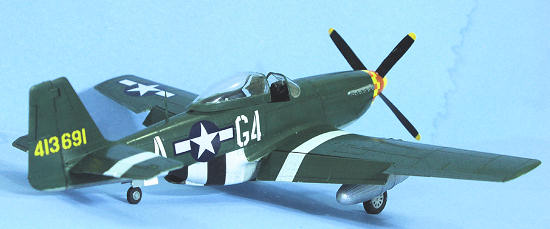 rivet detail
on the flap.
rivet detail
on the flap.
When I assembled the wings and horizontal stabilizers, I ran across a
problem with the separate trim tabs, that being their tendency to break off if
handled at all, with the result that I replaced two of them with Evergreen sheet
after they were sacrificed to the carpet monster.
I ended up gluing these in with cyanoacrylate glue, then sanding them
smooth and rescribing the outlines.
The parts for the cockpit ended up being mix-and-match from the
Greymatter set and the kit. The
Greymatter side panels and instrument panel were used, as was the forward
cockpit floorboard and the seat. The armor plate behind the seat and the
flooring and fuselage fuel tank provided were too wide, since they were made to
fit the too-wide fuselage of the Hasegawa kit; I used the parts provided by
Dragon, with some Evergreen sheet added to the edges of the flooring to fit
snugly.
The built-up multi-part gyroscopic gunsight Dragon provides is the
definition of “over-engineered,” as were the main gear legs, and the air over
the workbench turned a distinct purplish shade during the construction process
for these.
Mating the wing and fuselage sub-assemblies required more than a bit of
puttying, sanding, smoothing and rescribing of detail to finish off, but it was
nothing difficult.
Painting:
Over the years there has been much controversy about what colors were
used for the repainting of the 357th FG Mustangs.
This is complicated by the fact that nearly all photos of the aircraft
are black and white. Back in the
mid-1990s, I had the pleasure of knowing Hank Pfeiffer, the pilot of
“Tangerine,” out at Planes of Fame, and I had the chance to talk with him in
detail about this. The airplanes
were painted on the 357th's base, not at a maintenance unit, and used those
paints that could be found. Thus, some airplanes were in Olive Drab and Neutral
Grey, some were in RAF Dark Green and RAF Medium Sea Grey or RAF Ocean
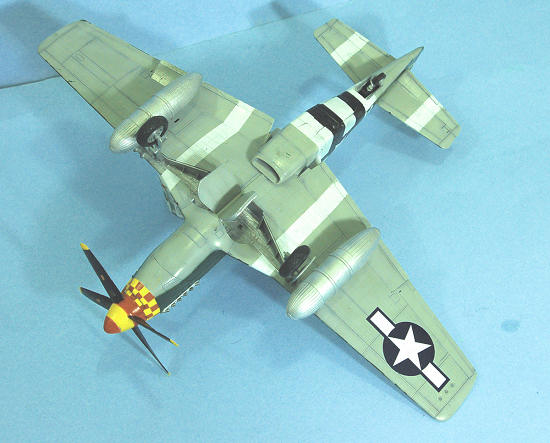 Grey, and
some were in US Medium Green and whatever shade of grey was available.
Thus, a modeler has a lot of choice, and no one can definitely prove or
disprove the accuracy in most cases.
Grey, and
some were in US Medium Green and whatever shade of grey was available.
Thus, a modeler has a lot of choice, and no one can definitely prove or
disprove the accuracy in most cases.
However, Jeff Ethell's “World War II In Color: 8th Air Force”
has two color photos of “Passion Wagon,” and it is definitely a “green” green,
not an olive green. Most likely, it
is US Medium Green. The lower surfaces
are a light grey that to me appears close to RAF Sea Grey Medium.
This was how I decided to paint this model.
I first painted the white stripe areas, masked them, applied black for
the lower fuselage D-Day stripes while pre-shading the rest of the model, masked
that and then freehanded Xtracrylix RAF Sea Grey Medium and Xtracrylix “US
Medium Green”. I added in a bit of
violet to the green paint when I went back over it, to hint at the high-altitude
UV sun fading the airplane would have been subject to in the ETO.
When finished, the model was given a coat of Future for decals.
Decals:
I used the Kits World decals for the individual markings and serial, and
the kit decals for the national insignia and other small markings. Everything
went down without problem under Micro-Sol.
I did note that the decals for “Hurry Home Honey,” the boxart airplane,
followed the incorrect Replicast decals for the name, with the wrong font and
done in black instead of red.
The photos I have of this airplane show it well-maintained, so I did not
“ding it.” I gave the model an
overall coat of Xtracrylix Satin clear coat, to simulate a waxed finish.
I attached the prop, landing gear, and drop tanks, unmasked the canopy
and positioned it open.
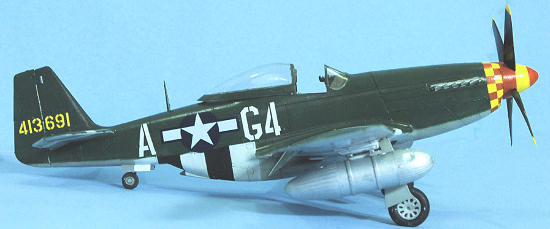 The kit still has problems it shouldn't have as the product of a major
company like Dragon, but it can obviously be built, if one has the aftermarket
parts to correct the more glaring inaccuracies.
Whether one wishes to go to this expense - given that the new Zooki Miura
company has announced a P-51D in their future releases - is individual choice,
but if you like the early P-51D, it is the only game in town.
And for those who still think “TC killed the hobby,” take a look at
Dragon's aircraft kit releases since this debacle.
Lesson learned??
The kit still has problems it shouldn't have as the product of a major
company like Dragon, but it can obviously be built, if one has the aftermarket
parts to correct the more glaring inaccuracies.
Whether one wishes to go to this expense - given that the new Zooki Miura
company has announced a P-51D in their future releases - is individual choice,
but if you like the early P-51D, it is the only game in town.
And for those who still think “TC killed the hobby,” take a look at
Dragon's aircraft kit releases since this debacle.
Lesson learned??
Tom Cleaver
November 2010
Review kit courtesy of a
friend; aftermarket items courtesy of Greymatter Figures. Get yours at
www.greymatterfigures.com
If you would like your product reviewed fairly and quickly, please
contact
me or see other details in the Note to
Contributors.
Back to the Main Page
Back to the Review
Index Page


 y
complain about any “flat‑hatting,” though 14 pilots were killed in accidents
during this time. The unit was ready for transfer to
y
complain about any “flat‑hatting,” though 14 pilots were killed in accidents
during this time. The unit was ready for transfer to  Throughout
the summer of 1944, the fighters of the Eighth, along with those of the Ninth
that were more and more based in
Throughout
the summer of 1944, the fighters of the Eighth, along with those of the Ninth
that were more and more based in  reviews of
the kit that sprouted on the internet in the months following revealed, a lot of
modelers wanted to prove me wrong, though their results were unconvincing on
that point, as was also pointed out by readers.
reviews of
the kit that sprouted on the internet in the months following revealed, a lot of
modelers wanted to prove me wrong, though their results were unconvincing on
that point, as was also pointed out by readers. Rutman
before he closed up shop, but I do not know any other replacements, so a modeler
is on their own at that point. I
was also fortunate to receive a resin cockpit from Greymatter Figures; this
cockpit was originally created for the 1/32 Hasegawa kit and they were
interested to find out if it could work with the Dragon kit, which it can with
some modifications. I wish I had
been able to use the Scale Aircraft Conversions white metal landing gear and
True Details resin main gear, because the parts provided in the kit are
deficient.
Rutman
before he closed up shop, but I do not know any other replacements, so a modeler
is on their own at that point. I
was also fortunate to receive a resin cockpit from Greymatter Figures; this
cockpit was originally created for the 1/32 Hasegawa kit and they were
interested to find out if it could work with the Dragon kit, which it can with
some modifications. I wish I had
been able to use the Scale Aircraft Conversions white metal landing gear and
True Details resin main gear, because the parts provided in the kit are
deficient. rivet detail
on the flap.
rivet detail
on the flap. Grey, and
some were in US Medium Green and whatever shade of grey was available.
Thus, a modeler has a lot of choice, and no one can definitely prove or
disprove the accuracy in most cases.
Grey, and
some were in US Medium Green and whatever shade of grey was available.
Thus, a modeler has a lot of choice, and no one can definitely prove or
disprove the accuracy in most cases.